Heat Pumps Are Becoming a Part of Our Future
Lower-Income Families Can Now Have Better Health, Reduced Utility Bills, and More Comfort

Nearly half of residential buildings in the U.S. were constructed before 1973, when building code energy standards were virtually nonexistent. As a result, most homes and residential buildings still rely on old technologies for heating and cooling: furnaces and boilers for heating and big rooftop air conditioning units for cooling.
Heat pumps, however, are gaining traction. The same piece of equipment can provide heating and cooling. Heat pumps are powered by electricity but have efficiencies 3-5 times that of fossil-fuel heating systems. Despite the name, heat pumps do not generate heat; they move it from one place to another. In heating mode, they absorb latent heat energy from the outside air, even cold air, and transfer this heat to indoor air. The condenser and evaporative coil, which are located outdoors, use a liquid called a refrigerant to soak up heat and move it indoors or capture it indoors and release it outside, depending on where heat or coolness is needed. The source of thermal energy for a heat pump can be the air (an air-source heat pump) or the ground (a ground-source heat pump).
Refrigerators are heat pumps but with the condenser located at the back or bottom of the appliance. We feel heat around a refrigerator because it is pulling heat out of the cold air inside the unit, thereby making it even cooler. A big plus that heat pumps offer is improved indoor air quality because there is no combustion.
There are also heat-pump water heaters and heat-pump clothes washers and dryers. Efforts are underway to create a household system where one compressor placed outside can power these various heat-pump services.
It has been known for decades that saving energy is cheaper than creating fossil-fuel energy. Investing in such efficiencies has among the best return-on-investment. In 2021, Americans spent an average of $1,380 per year on energy bills. Installing efficient windows; preventing air leaks; insulating roofs, attics, crawlspaces and walls; and changing existing lighting to LEDs, together with investing in heat pumps, can cut utility bills by more than half.
The Inflation Reduction Act that President Biden signed into law last August invests $369 billion in climate reducing strategies over the next decade — a big part of which will go for energy retrofits and electrification of homes for moderate-income and disadvantaged families. The many jobs created by doing these retrofits and improvements will be local and primarily benefit small companies.
If buildings around the globe are electrified and the sources of that electricity are from renewables, by 2050, one-sixth of the world’s total greenhouse-gas emissions would be eliminated.
Support the Santa Barbara Independent through a long-term or a single contribution.



